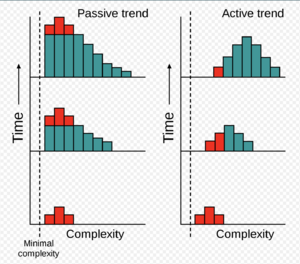复杂适应系统
复杂适应系统 Complex adaptive system (CAS)是一种系统,在这种系统中,对系统单个组成单元的理解并不能完美解释系统的整体行为[1]。在复杂适应系统中,系统的整体比其单独某个部分[2]或部分之和都更加复杂、更有意义。复杂适应系统是非线性动力系统的子集[3],其研究高度跨学科,融合了自然科学和社会科学的知识开发出了系统级的模型和见解,从而使得系统可以实现异质主体 Heterogeneous agents、相变 Phase transition 和涌现行为 Emergent behavior[4] 。
这种系统是复杂系统/复杂的,因为它们是动态的交互网络 Dynamic network analysis,并不是单个静态实体的简单聚合,也就是说,集合的行为不能通过每个组件的行为来进行预测。[5][6][1] 同时它们也是适应性的,因为个体和集体的行为会随着微事件或事件集合的发生而进行变异或自我组织。[5][6][1]
概述 Overview
复杂适应系统这个术语,或者复杂性科学 Complexity science,经常被用来描述围绕此类系统研究而成长起来的松散组织的(这里”松散组织的“个人认为可以意译为”相关的“即可)学术领域。复杂性科学不是一个单一的理论——它包含不止一个理论框架,并且是高度跨学科的,目标是寻求一些关于活的、可适应的、可变的系统的基本问题的答案。针对复杂适应系统的研究可以采用硬方法或软方法[7]:硬性理论使用精确的形式语言,倾向于认为主体本身具有有形的属性,并且通常认为行为系统中的物体可以以某种方式被操纵;而软理论则使用自然语言和可能不精确的叙述,而主体是同时具有有形和无形属性。硬复杂性理论包括复杂适应系统理论和生存理论,其中一类较为软性的理论是生存系统理论。硬理论中提出的许多命题也与软理论有关。自此之后,人们的研究兴趣将集中在复杂适应系统上。
复杂适应系统的研究主要集中在系统的复杂性、涌现性和宏观性质上。[8][9][10]
复杂适应系统的典型例子包括: 气候、城市、企业、市场、政府、工业、生态系统、社交网络、电网、动物群落、交通流、社会昆虫群体(例如:蚁群)[11]等。除此之外,互联网和网络空间等由复杂的人机交互组成、协作和管理的网络系统也被视为复杂适应性系统。[12][13][14]
一般性质 General properties
复杂适应系统(CAS)与纯多智能体系统 Multi-agent system(MAS)的区别在于,CAS更关注顶层性质和特征,比如自相似性、复杂性、涌现性和自组织。并且,多智能体系统是由多个相互作用的组件组成的系统,而在 CAS 系统中,组件与系统之间是自适应的,系统是自相似的。CAS是一个复杂的、自相似的、相互作用的自适应组件的集合。其特点就是具有高度的自适应能力,能够使其在面对干扰时具有一定的恢复能力。
复杂适应系统的其他重要属性分别是适应(或者说是内稳态 Homeostasis)、沟通、合作、专业化、时空组织和繁殖。这些特点可以在各个层面上被发现: 细胞分化、适应和繁殖,就像大型生物一样;沟通和合作也发生在各个层面,从个体到系统层面。在某些情况下,可以用博弈论 Game theory分析这种系统中主体之间合作的驱动力。
特点 Characteristics
复杂系统的一些最重要的特征是:[15]
- 个体的数量足够大,以至于常规描述(如微分方程 Differential equation系统)不仅不切实际,而且不再有助于理解该系统。此外,系统个体之间发生动力学上的相互作用,并且这种相互作用既可以是物理的,也可以是信息的交换;
- 这样的相互作用是丰富的,即系统中的任何个体或子系统都受到并影响其他的个体或子系统;
- 个体间相互作用是非线性 Non-linear的:系统输入、个体间的物理相互作用或刺激的微小变化都可能会导致较大的影响,或使得输出发生非常显著的变化;
- 相互作用以及受影响性质的调整主要但不仅限于其直接邻居;
- 任何相互作用都可以直接或在多个干预阶段之后间接反馈到自身,此类反馈的质量可能会有所不同。这种现象称为重复发生 Recurrency;
- 系统的整体行为无法通过单个个体的行为来预测;
- 这样的系统可能是开放的,这使得我们很难或不可能定义系统的边界;
- 复杂系统在非平衡态(远离平衡态)的条件下运行,必须要有恒定的能量流来维持系统的组织;
- 复杂系统具有历史信息,它们不断演化发展,其历史信息对现在的系统行为具有一定的影响;
- 系统中的个体可能并不了解整个系统的行为,因此仅会对局域的可用信息或物理刺激做出响应。
从建模的角度来看,罗伯特·阿克塞尔罗德 Robert Axelrod和迈克尔·科恩 Michael D. Cohen[16] 还确定了一系列关键术语:
- 策略 Strategy:一种有条件的行为模式,指示系统在什么情况下该做什么;
- 工件 Artifact (这里的专有名词的翻译有待商榷):一种具有确定位置并可以响应个体行为的物质资源;
- 主体 Agent:用于与工件和其他个体进行交互的属性,策略和功能的集合;
- 种群 Population:个体的集合,或在某些情况下,策略的集合;
- 系统 System:是一个较大的集合,包括一个或多个个体的群体,可能还包括工件 artifacts ;
- 类型 Type:总体中具有某些共同特征的所有主体(或策略);
- 种类 Variety:种群或系统中类型的多样性;
- 交互模式 Interaction pattern:系统内类型之间的重复接触规律;
- 空间(物理) Space (physical):个体和工件在地理空间或时间中的位置;
- 空间(概念) Space (conceptual):“位置”在一组结构合理的类别中,以便“附近”的个体进行交互;
- 选择 Selection:导致各种类型的个体或策略发生频率增加或减少的过程;
- 成功标准 Success criteria 或 评价指标 Performance measures:指评价个体或设计者在选择相对成功(或不成功)的策略或个体时的“分数”。
- 特纳 Turner和贝克 Baker[17]从文献中综合了复杂适应系统的特征,并在创造力和创新的背景下测试了这些特征。这八个特点中的每一个都显示出在创造性和创新过程中存在:
- 路径依赖 Path dependent:系统状态对初始条件敏感,相同的力在不同初始条件下可能会对系统产生不同的影响;[18]
- 系统具有历史 Systems have a history:系统的未来行为取决于其初始状态和后续的历史;[19]
- 非线性 Non-linearity:对环境扰动的反应过大,结果与简单系统的结果不同;[20] [21]
- 涌现 Emergence:每个系统内部动力学影响其状态改变和改变能力的方式,可能与其他系统完全不同;[22]
- 不可还原 Irreducible :其过程转换是不可逆的,无法还原到其原始状态;[23]
- 适应性/适应能力 Adaptive/Adaptability:同时处于有序和无序状态的系统更具适应性和恢复力;[24]
- 在有序和混沌之间运行 Operates between order and chaos:自适应张力是由系统与其所处环境之间的能量差产生的;[25]
- 自组织 Self-organizing :系统由相互依赖、相互作用的组成部分以及系统的多样性组成。[26]
系统的建模与仿真 Modeling and simulation
CAS有时可以用基于主体的模型 Agent-based model和基于复杂网络的模型 Complex network-based models来建模。[27]基于主体的模型主要是通过识别模型中的不同主体,利用各种方法和工具开发的。[28] 而开发复杂适应系统模型的另一种方法,则是利用复杂适应系统各组成部分的交互数据来构建复杂的网络模型。[29]
2013年,SpringerOpen/BioMed Central 推出了一个开放的在线获取期刊平台,其主题就是关于复杂适应性系统建模(CASM)。[30]
复杂性的演变 Evolution of complexity
复杂性演变中的消极趋势与积极趋势如图所示。在进程的开始时整个CAS系统是红色的,系统数量的变化由条形图的高度来表示,每一组图在一个时间序列中向上移动。
生命体是复杂的适应系统。 尽管很难在生物学中量化复杂性,.[31]但进化确实产生了一些非常复杂的生物。这种现象导致对进化的普遍误解是”进化是渐进的,并产生了所谓的’高级生物‘“。[32]
假设这种说法是普遍正确的,那么进化就会朝着复杂的方向发展。如下所示,在这类过程中,最常见的复杂性程度会随着时间的推移而增加。[33]而事实上,一些人工生命模拟已经表明,CAS的产生是进化过程中不可避免的特征。[34][35]
然而,复杂性在进化中的普遍趋势的观点也可以通过一个被动的过程来解释。这涉及到方差的增加,但是最常见的值(即模式),并没有改变。因此,复杂性的最大水平随着时间的推移而增加,但仅仅是总体上有更多生物体的间接产物。这种随机过程也称为有界随机游走 Bounded random walk。
在这一假设中,向更复杂的生物体发展的明显趋势是一种错觉,因为它只注意到了居住在复杂性分布的右端的少数大型、非常复杂的生物体,而忽略了更简单和更普通的生物体。这个被动模型强调,绝大多数物种是微小的原核生物,[36]它们构成了世界生物量的一半,[37] 构成了地球生物多样性的绝大多数。[38] 因此,简单生命在地球上仍然占主导地位,而复杂生命仅仅因为抽样的偏差而显得更加多样化。
如果在生物学中缺乏一个复杂性的总体趋势,这并不排除在一个子集的情况下驱动系统走向复杂性的力量的存在。这些小的趋势将被其他的进化压力所平衡,这些进化压力驱使系统朝着不那么复杂的状态发展。
相关概念
参考文献
- ↑ 1.0 1.1 1.2 Miller, John H., and Scott E. Page (2007-01-01). Complex adaptive systems : an introduction to computational models of social life. Princeton University Press. ISBN 9781400835522. OCLC 760073369.
- ↑ Holland, J. H. (1998). Emergence: From chaos to order. Reading, MA: Helix Books.
- ↑ Lansing, J. Stephen (2003). "Complex Adaptive Systems". Annual Review of Anthropology. Annual Reviews. 32 (1): 183–204. doi:10.1146/annurev.anthro.32.061002.093440. ISSN 0084-6570.
- ↑ Auerbach, David (2016-01-19). "The Theory of Everything and Then Some". Slate (in English). ISSN 1091-2339. Retrieved 2017-03-07.
- ↑ 5.0 5.1 "Insights from Complexity Theory: Understanding Organisations better". by Assoc. Prof. Amit Gupta, Student contributor - S. Anish, IIM Bangalore. Retrieved 1 June 2012.
- ↑ 6.0 6.1 "Ten Principles of Complexity & Enabling Infrastructures". by Professor Eve Mitleton-Kelly, Director Complexity Research Programme, London School of Economics. CiteSeerX 10.1.1.98.3514.
{{cite journal}}: Cite journal requires|journal=(help) - ↑ Yolles, Maurice (2018). "The complexity continuum, Part 1: hard and soft theories". Kybernetes. 48 (6): 1330–1354. doi:10.1108/K-06-2018-0337.
- ↑ Faucher, Jean-Baptiste. "A Complex Adaptive Organization Under the Lens of the LIFE Model:The Case of Wikipedia". Egosnet.org. Retrieved 25 August 2012.
- ↑ "Evolutionary Psychology, Complex Systems, and Social Theory" (PDF). Bruce MacLennan, Department of Electrical Engineering & Computer Science, University of Tennessee, Knoxville. eecs.utk.edu. Retrieved 25 August 2012.
- ↑ "Complex Adaptive Systems as a Model for Evaluating Organisational : Change Caused by the Introduction of Health Information Systems" (PDF). Kieren Diment, Ping Yu, Karin Garrety, Health Informatics Research Lab, Faculty of Informatics, University of Wollongong, School of Management, University of Wollongong, NSW. uow.edu.au. Archived from the original (PDF) on 5 September 2012. Retrieved 25 August 2012.
- ↑ Steven Strogatz, Duncan J. Watts and Albert-László Barabási "explaining synchronicity (at 6:08), network theory, self-adaptation mechanism of complex systems, Six Degrees of separation, Small world phenomenon, events are never isolated as they depend upon each other (at 27:07) in the BBC / Discovery Documentary". BBC / Discovery. Retrieved 11 June 2012. "Unfolding the science behind the idea of six degrees of separation"
- ↑ "The Internet Analyzed as a Complex Adaptive System". Retrieved 25 August 2012.
- ↑ "Cyberspace: The Ultimate Complex Adaptive System" (PDF). The International C2 Journal. Retrieved 25 August 2012. by Paul W. Phister Jr
- ↑ "Complex Adaptive Systems" (PDF). mit.edu. 2001. Retrieved 25 August 2012. by Serena Chan, Research Seminar in Engineering Systems
- ↑ Paul Cilliers (1998) Complexity and Postmodernism: Understanding Complex Systems
- ↑ Robert Axelrod & Michael D. Cohen, Harnessing Complexity. Basic Books, 2001
- ↑ Turner, J. R., & Baker, R. (in press). Just doing the do: A case study testing creativity and innovative processes as complex adaptive systems. New Horizons in Adult Education and Human Resource Development.
- ↑ Lindberg, C.; Schneider, M. (2013). "Combating infections at Maine Medical Center: Insights into complexity-informed leadership from positive deviance". Leadership. 9 (2): 229–253. doi:10.1177/1742715012468784.
- ↑ Boal, K. B.; Schultz, P. L. (2007). "Storytelling, time, and evolution: The role of strategic leadership in complex adaptive systems". The Leadership Quarterly. 18 (4): 411–428. doi:10.1016/j.leaqua.2007.04.008.
- ↑ Lindberg, C.; Schneider, M. (2013). "Combating infections at Maine Medical Center: Insights into complexity-informed leadership from positive deviance". Leadership. 9 (2): 229–253. doi:10.1177/1742715012468784.
- ↑ Luoma, M (2006). "A play of four arenas - How complexity can serve management development". Management Learning. 37: 101–123. doi:10.1177/1350507606058136.
- ↑ Lindberg, C.; Schneider, M. (2013). "Combating infections at Maine Medical Center: Insights into complexity-informed leadership from positive deviance". Leadership. 9 (2): 229–253. doi:10.1177/1742715012468784.
- ↑ Borzillo, S.; Kaminska-Labbe, R. (2011). "Unravelling the dynamics of knowledge creation in communities of practice through complexity theory lenses". Knowledge Management Research & Practice. 9: 353–366. doi:10.1057/kmrp.2011.13.
- ↑ Lindberg, C.; Schneider, M. (2013). "Combating infections at Maine Medical Center: Insights into complexity-informed leadership from positive deviance". Leadership. 9 (2): 229–253. doi:10.1177/1742715012468784.
- ↑ Borzillo, S.; Kaminska-Labbe, R. (2011). "Unravelling the dynamics of knowledge creation in communities of practice through complexity theory lenses". Knowledge Management Research & Practice. 9: 353–366. doi:10.1057/kmrp.2011.13.
- ↑ Lindberg, C.; Schneider, M. (2013). "Combating infections at Maine Medical Center: Insights into complexity-informed leadership from positive deviance". Leadership. 9 (2): 229–253. doi:10.1177/1742715012468784.
- ↑ Muaz A. K. Niazi, Towards A Novel Unified Framework for Developing Formal, Network and Validated Agent-Based Simulation Models of Complex Adaptive Systems PhD Thesis
- ↑ John H. Miller & Scott E. Page, Complex Adaptive Systems: An Introduction to Computational Models of Social Life, Princeton University Press Book page
- ↑ Melanie Mitchell, Complexity A Guided Tour, Oxford University Press, Book page
- ↑ Springer Complex Adaptive Systems Modeling Journal (CASM)
- ↑ Adami C (2002). "What is complexity?". BioEssays. 24 (12): 1085–94. doi:10.1002/bies.10192. PMID 12447974.
- ↑ McShea D (1991). "Complexity and evolution: What everybody knows". Biology and Philosophy. 6 (3): 303–24. doi:10.1007/BF00132234.
- ↑ Carroll SB (2001). "Chance and necessity: the evolution of morphological complexity and diversity". Nature. 409 (6823): 1102–9. Bibcode:2001Natur.409.1102C. doi:10.1038/35059227. PMID 11234024.
- ↑ Furusawa C, Kaneko K (2000). "Origin of complexity in multicellular organisms". Phys. Rev. Lett. 84 (26 Pt 1): 6130–3. arXiv:nlin/0009008. Bibcode:2000PhRvL..84.6130F. doi:10.1103/PhysRevLett.84.6130. PMID 10991141.
- ↑ Adami C, Ofria C, Collier TC (2000). "Evolution of biological complexity". Proc. Natl. Acad. Sci. U.S.A. 97 (9): 4463–8. arXiv:physics/0005074. Bibcode:2000PNAS...97.4463A. doi:10.1073/pnas.97.9.4463. PMC 18257. PMID 10781045.
- ↑ Oren A (2004). "Prokaryote diversity and taxonomy: current status and future challenges". Philos. Trans. R. Soc. Lond. B Biol. Sci. 359 (1444): 623–38. doi:10.1098/rstb.2003.1458. PMC 1693353. PMID 15253349.
- ↑ Whitman W, Coleman D, Wiebe W (1998). "Prokaryotes: the unseen majority". Proc Natl Acad Sci USA. 95 (12): 6578–83. Bibcode:1998PNAS...95.6578W. doi:10.1073/pnas.95.12.6578. PMC 33863. PMID 9618454.
- ↑ Schloss P, Handelsman J (2004). "Status of the microbial census". Microbiol Mol Biol Rev. 68 (4): 686–91. doi:10.1128/MMBR.68.4.686-691.2004. PMC 539005. PMID 15590780.
其他参考资料
- Ahmed E, Elgazzar AS, Hegazi AS (28 June 2005). "复杂的自适应系统概述 An overview of complex adaptive systems". Mansoura J. Math. 32: 6059. arXiv:nlin/0506059. Bibcode:2005nlin......6059A. arXiv:nlin/0506059v1 [nlin.AO].
- Bullock S, Cliff D (2004). "ICT系统中的复杂性和突发行为 Complexity and Emergent Behaviour in ICT Systems". Hewlett-Packard Labs. HP-2004-187.
{{cite journal}}: Cite journal requires|journal=(help); commissioned as a report by the UK government's Foresight Programme.
- Dooley, K., 社会科学的复杂性 Complexity in Social Science glossary a research training project of the European Commission.
- Edwin E. Olson; Glenda H. Eoyang (2001). 促进组织变革 Facilitating Organization Change. San Francisco: Jossey-Bass. ISBN 0-7879-5330-X.
- Gell-Mann, Murray (1994). 夸克和美洲虎:简单与复杂的冒险 The quark and the jaguar: adventures in the simple and the complex. San Francisco: W.H. Freeman. ISBN 0-7167-2581-9.
- Holland, John H. (1992). 自然和人工系统中的适应性:介绍性分析及其在生物学,控制和人工智能中的应用 Adaptation in natural and artificial systems: an introductory analysis with applications to biology, control, and artificial intelligence. Cambridge, Massachusetts: MIT Press. ISBN 0-262-58111-6. https://archive.org/details/adaptationinnatu00holl.
- Holland, John H. (1999). 涌现:从混乱到有序 Emergence: from chaos to order. Reading, Mass: Perseus Books. ISBN 0-7382-0142-1.
- Solvit, Samuel (2012). 战争的维度:将战争理解为复杂的自适应系统 Dimensions of War: Understanding War as a Complex Adaptive System. Paris, France: L'Harmattan. ISBN 978-2-296-99721-9.
- Kelly, Kevin (1994) (Full text available online). 失控:机器,社会系统和经济世界的新生物学 Out of control: the new biology of machines, social systems and the economic world. Boston: Addison-Wesley. ISBN 0-201-48340-8. https://archive.org/details/outofcontrolnewb00kell.
- M.C. (online). Looking to systems theory for a reductive explanation of phenomenal experience and evolutionary foundations for higher order thought Retrieved 15 January 2008.
- Hobbs, George & Scheepers, Rens (2010),"信息系统中的敏捷性:启用IT功能的能力 Agility in Information Systems: Enabling Capabilities for the IT Function," 信息系统协会太平洋杂志 Pacific Asia Journal of the Association for Information Systems: Vol. 2: Iss. 4, Article 2. Link
- Sidney Dekker (2011). 陷入故障:从寻找损坏的组件到了解复杂的系统 Drift into Failure: From Hunting Broken Components to Understanding Complex Systems. CRC Press.
相关链接 External links
- Complex Adaptive Systems Group 复杂自适应系统小组 对复杂的自适应系统感兴趣的科学家和软件工程师之间的松散耦合 loosely coupled group of scientists and software engineers interested in complex adaptive systems
- DNA Wales Research Group DNA威尔士研究小组 组织变更方面的最新研究,关于CAS/CES的相关新闻和免费研究数据,还链接到Business Doctor&BBC纪录片系列。 Current Research in Organisational change CAS/CES related news and free research data. Also linked to the Business Doctor & BBC documentary series
- A description 说明 of complex adaptive systems on the Principia Cybernetica Web.原理网上的复杂自适应系统的设计
- Quick reference 快速参考 single-page description of the 'world' of complexity and related ideas hosted by the Center for the Study of Complex Systems at the University of Michigan. 密歇根大学复杂系统研究中心主办的关于复杂性“世界”及相关思想的单页描述。
- TEDxRotterdam - Igor Nikolic - Complex adaptive systems, and The emergence of universal consciousness: Brendan Hughes at TEDxPretoria . Talks discussing various practical examples of complex adaptive systems, including Wikipedia, star galaxies, genetic mutation, and other examples 讨论讨论复杂自适应系统的各种实际示例,包括Wikipedia,星系,遗传突变和其他示例
编者推荐
集智相关课程
演化与适应:从存在到演化
本课程将介绍关于系统的动力学与复杂系统的演化。
复杂网络的基本模型
本课程中,将详细介绍复杂网络的四个基本模型:规则网,随机图,小世界网络,无标度网络。
本词条内容源自wikipedia及公开资料,遵守 CC3.0协议。

